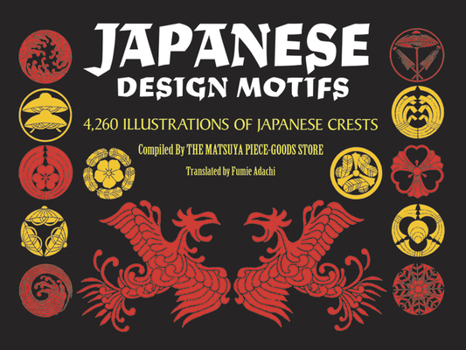Japanese Design Motifs: 4,260 Illustrations of Japanese Crests
Select Format
Select Condition 
Book Overview
This collection presents more than 4,000 individual designs in the 900-year-old tradition of Japanese family crests. Through constant variation and invention over the centuries, this has become one of the richest graphic art traditions in the world. Most of these motifs are circular, and they can all be fitted into a square. Within those limitations is a seemingly endless range of designs, beginning with the dozens and dozens of root motifs -- rice plant, gingko, scallop, lightning, anchor, spool, raft, candle, scissors, fern, saki bottle, lotus blossom, mountain arrow, pine, wisteria, ship, rabbit, and scores of others. Practically every kind of plant, bird, animal, natural phenomenon, and manufactured object of Japanese culture was at one time or another included in a family crest. In addition, each of the root designs was treated to dozens of imaginative variations -- they were reproduced bilaterally, in triangles, diamonds, five- and six-pointed stars, in spirals, were built up in series, made to overlap, combined with each other, and so on. Some of these are classic and recognizable designs, like the yin-yang, linked rings, and treasure knot. Many of the others have rarely been seen in the West. Graphic artists, textile designers, pattern-makers, advertisers, and other commercial artists looking for an untapped source of novel, appealing designs will find a wealth of material here. Some of these motifs can be used to suggest an exotic flavor, and others are universal and can be used almost anywhere.
Format:Paperback
Language:English
ISBN:0486228746
ISBN13:9780486228747
Release Date:June 1972
Publisher:Dover Publications
Length:213 Pages
Weight:1.52 lbs.
Dimensions:0.6" x 11.3" x 8.3"
Customer Reviews
5 ratings
Comprehensive and logically organized
Published by Thriftbooks.com User , 19 years ago
Supposedly, there are about 2,000 Japanese family crests, with origins that reach back more than a millenium. And while I can't say whether this book contains all two thousand, it's nevertheless pretty comprehensive. They're presented in columns of black images--each image about 2" in diameter--and grouped by theme (e.g., crests depicting one cherry blossom, then crests based on 2 blossoms, then crests based on 3 blossoms, etc.). Like other Dover art books, this one is primarily for artists and designers, rather than for students of history/culture. (I used these images for stencilling, during an Anglo-Japanese makeover of our 1870s-era house--and discovered that "chinoiserie" abounds, but "japanesque" is rare. This book became part of an invaluable, and small, set of resources.)
Fantastic for Graphic Design Inspiration
Published by Thriftbooks.com User , 22 years ago
Page, after page, after page of great designs. Not something you can use for research, but it you are looking for inspiration, this is a book for you. I started putting yellow post-its on the designs I wanted to use (quilting, cross-stitch, stained glass), but I soon gave up when I realized that I was marking almost every page. This is one of those rare design books that is well worth the money.
Well worth the price...
Published by Thriftbooks.com User , 22 years ago
I've lusted after this book ever since I saw it in the library years ago. Unfortunately, I couldn't remember the name (I should've stolen it then!). So what a delight to finally rediscover it. The images in this book have haunted me, and defied my attempts to recreate even a few of them from memory. There are more permutations on each motif than one can possibly think of. An endless wealth of source material for logos, symbols, backgrounds, graphics. This book is a must-have for any designer interested in or influenced by Japanese design!
Nice clean cut stuff.
Published by Thriftbooks.com User , 24 years ago
This stuff is eye candy to anyone who does graphic design of any sort that uses 2D graphics. My mother gets ideas for quilting patterns and I've been inspired several times while looking through the book and gone and loaded up photoshop and started messin around. This stuff is surprisingly beuitful and fascinating when you notice how simple the designs are.
Matsuya Crest Catalogue Outstanding Resource
Published by Thriftbooks.com User , 24 years ago
The Matsuya catalogue of crests is a resource of remarkable depth and breadth for serious students of Japanese design history. Although it lacks the interpretive text of John Dower's classic study on Japanese crests, the unusually large number and relatively complete range of crests pictured allow readers to draw solid conclusions about the relative popularity of certain motifs, like plum blossoms or oak leaves, in Japanese history and to examine how different motifs--such as the Big Dipper and crescent moon or rabbit and high waves--were combined. If one is able to read Japanese, the names of the specific crest designs convey additional valuable information. One of the many copyright-free books published by Dover, the Matsuya catalogue also provides a treasure trove of reproduction-quality design material.





